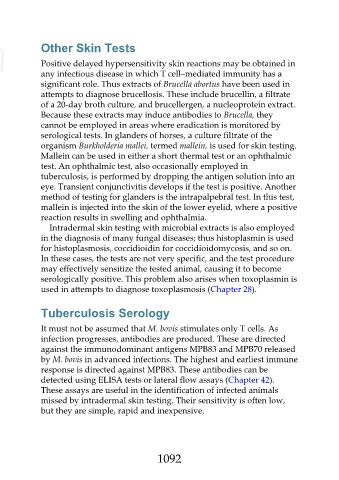Page 1092 - Veterinary Immunology, 10th Edition
P. 1092
Other Skin Tests
VetBooks.ir Positive delayed hypersensitivity skin reactions may be obtained in
any infectious disease in which T cell–mediated immunity has a
significant role. Thus extracts of Brucella abortus have been used in
attempts to diagnose brucellosis. These include brucellin, a filtrate
of a 20-day broth culture, and brucellergen, a nucleoprotein extract.
Because these extracts may induce antibodies to Brucella, they
cannot be employed in areas where eradication is monitored by
serological tests. In glanders of horses, a culture filtrate of the
organism Burkholderia mallei, termed mallein, is used for skin testing.
Mallein can be used in either a short thermal test or an ophthalmic
test. An ophthalmic test, also occasionally employed in
tuberculosis, is performed by dropping the antigen solution into an
eye. Transient conjunctivitis develops if the test is positive. Another
method of testing for glanders is the intrapalpebral test. In this test,
mallein is injected into the skin of the lower eyelid, where a positive
reaction results in swelling and ophthalmia.
Intradermal skin testing with microbial extracts is also employed
in the diagnosis of many fungal diseases; thus histoplasmin is used
for histoplasmosis, coccidioidin for coccidioidomycosis, and so on.
In these cases, the tests are not very specific, and the test procedure
may effectively sensitize the tested animal, causing it to become
serologically positive. This problem also arises when toxoplasmin is
used in attempts to diagnose toxoplasmosis (Chapter 28).
Tuberculosis Serology
It must not be assumed that M. bovis stimulates only T cells. As
infection progresses, antibodies are produced. These are directed
against the immunodominant antigens MPB83 and MPB70 released
by M. bovis in advanced infections. The highest and earliest immune
response is directed against MPB83. These antibodies can be
detected using ELISA tests or lateral flow assays (Chapter 42).
These assays are useful in the identification of infected animals
missed by intradermal skin testing. Their sensitivity is often low,
but they are simple, rapid and inexpensive.
1092

